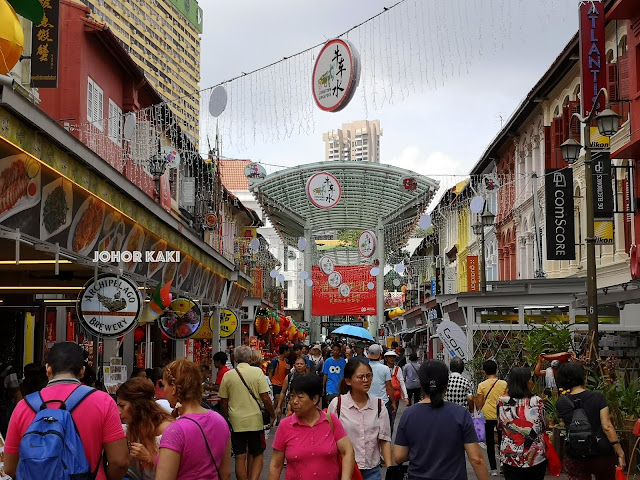
For 200 years, Singapore's Chinatown has been the focal point of Chinese coming to Nanyang 南洋 (Southeast Asia) - the first Chinese junk arrived at Singapore River in 1821. Each successive wave of 新客 new arrivals brought another layer of culture and customs to Chinatown. Food is an edible heritage we can see, smell, touch and taste - and, memories of it lodge in our taste buds and minds.

Today, food from north China has the most prominent visible presence in Chinatown. Still, the unique food culture of the pioneer waves arriving in Nanyang in 1800s to early 1900s can still be found in pockets beneath the overlay of cuisine of the post Millennium immigration wave. This tour highlights the heritage Nanyang food of pioneer Chinese immigrants that still exists in Chinatown.
Establishments in the itinerary are chosen for the edible heritage they represent. We get a feel of early Singapore and insights into our pioneers' way of life by seeing how heritage food is made and experience how it tastes.
The tour conducted in English takes around 90 minutes (was conducted on 23 & 24 Mar 2019 from 4:00pm - 5:30pm as part of the Five Foot Way Festival). With this post, you will be able to self guide yourself through Chinatown in search of the fading Nanyang heritage.
Pagoda Street 宝塔街

The tour starts conveniently at Exit A of Chinatown MRT station at Pagoda Street. Pagoda Street is named after the tower of Sri Mariamman Temple at the southern end of the street.

👣👣 We start off walking north towards New Bridge Road and then east (turn right) towards Upper Cross Street.
In the short stretch of New Bridge Road there are three big names in Singapore bak kwa 肉干, namely Fragrance, Lim Chee Guan and Bee Cheng Hiang. Bak kwa is charcoal grilled marinated pork slices originally from Fujian, China where over 40% of our pioneer immigrants came from.
Lim Chee Guan is a stalwart, being in Chinatown (Chin Chiew Street) since 1938 i.e. before the Second World War (1939-1945). During Chinese New Year when demand for bak kwa is at its annual peak, the queue for Lim Chee Guan bak kwa snakes all the way back to Chinatown MRT station where we started our trail.
For many Singaporeans, queuing hours for Lim Chee Guan bak kwa is part and parcel of their Chinese New Year rituals. The great effort in securing the bak kwa is seen as an expression of love and sincerity towards the person(s) who will receive the bak kwa as a gift.

Bee Cheng Hiang is undoubtedly the most commercially successful bak kwa brand in the world with 376 outlets and still growing. Founded by Teo Swee Ee in 1933, who made and sold his bak kwa on two baskets slung across his shoulders. He plied his trade in the streets of old Chinatown, the very same streets we are walking on now. BCH have been running this outlet on New Bridge Road since 1950s. This white colour block used to be public housing built by SIT (Singapore Improvement Trust) which is the precursor of HDB (Housing Development Board).

Teo Swee Ee coined the name Bee Cheng Hiang. The Chinese characters 美, 珍 and 香 each has 9 strokes. The number 9 is considered auspicious in Chinese as it symbolises values such as longevity, permanence, endurance etc. 美, 珍 and 香 also refers to the desired appearance, flavour and aroma of Bee Cheng Hiang bak kwa. Solid enduring foundation Mr. Teo set for the company in just 3 words 👏👏👏
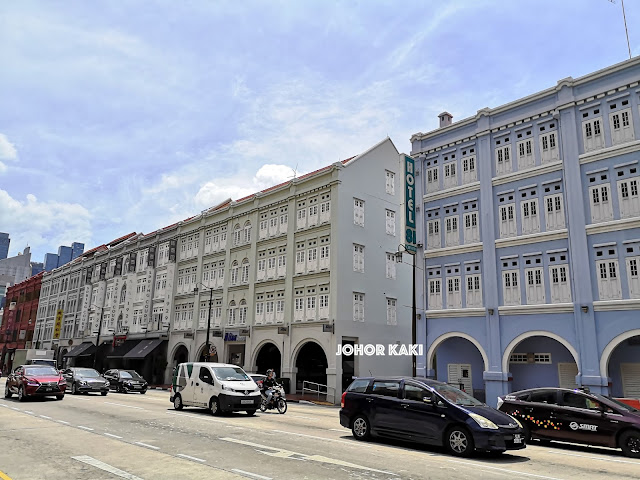
👣👣 At the intersection of New Bridge Road and Upper Cross Street, we turn right and head south down Upper Cross Street (traffic flows in the opposite direction).
The Chinese used to call this street Hai San Street 海山街 as the Hai San Secret Society was dominant here. The street was also known as Kling Street as Indian traders in Chinatown lived here in the 1800s.

Photo credit: Wikipedia
The Hai San Secret Society founded in Penang in 1820 was active throughout British Malaya. Secret societies were engaged in constant deadly territorial struggles big and small. The biggest was the Larut Wars (1862 - 1873) between Hai San and Ghee Hin over personal grudges and control of the tin mines of Perak and Selangor. Larut was renamed Taiping (太平 meaning peace) to mark the truce in 1874 between Hai San and Ghee Hin.

Not food strictly speaking, but Nanyang medicated oils are also unique to our Nanyang heritage. When our forefathers arrived in Southeast Asia, many suffered aches, pains and injuries from strenuous labour and poor living conditions. Entrepreneurs with knowledge of herbs and medicine formulated medicated oils to help relieve the symptoms.
They used available herbs and oils in Singapore to make medicated oils and ointments. The most famous is Tiger Balm but there are other brands including over century old Chop Wah On on Upper Cross Street. Today, traditional Singapore medicated oils are highly sought after by Chinese communities around the world.

On Upper Cross Street, there are two famous soya sauce chicken shops. Chew Kee and Chiew Kee which both come from the same roots founded 70 years ago making it the first in Singapore to sell this dish. The sign on the pillar at Chiew Kee boldly declare they are 油鸡第一家, Singapore's first soya sauce chicken shop.

Chew Kee Eating House 釗記面家 also has a sign laying claim that it is 油鸡第一家, the first in Singapore to serve soya sauce chicken (in 1947).

Other restaurants soon had soya sauce chicken on their menu, including New Nam Thong Tea House on Smith Street. New Nam Thong Tea House owner's daughter Maria started a soya sauce chicken stall in Chinatown Complex Food Centre in 1983. One of her staff was hawker Chan who came to Singapore from Ipoh in 1988. Chan later started his own hawker stall Liao Fan in 2009. Hawker Chan was awarded a Michelin Star in 2016 - the first street food hawker to receive the honour. Now, Liao Fan Hawker Chan outlets opened in lpoh, Taipei, Manila, Bangkok and Melbourne. Remember, Singapore soya sauce chicken started here at Chew Kee Eating House on Upper Cross Street.
👣👣 From Upper Cross Street, we turn right and U turn back to Mosque Street.
Mosque Street 摩士街

Mosque Street is named after the Jamae Mosque or Masjid Jamae on South Bridge Road at the southern end of Mosque Street.

Pek Sin Choon Tea Merchants 白新春茶庄 - founded in 1925, Pek Sin Choon the oldest tea shop in Chinatown was responsible for popularising Chinese tea and bak kut teh pairing - the teh in Singapore bak kut teh.
Singapore's unique peppery style of bak kut teh was created at the banks of Singapore River. Through the tireless efforts of Pek Sin Choon, drinking Chinese tea became inseparably intertwined with Singapore's bak kut teh culture. Pek Sin Choon supplies Chinese tea to at least 80% of bak kut teh restaurants in Singapore. Pek Sin Choon still lovingly hand wraps their tea with pink paper.
Read more about Pek Sin Choon 👈 click

Tai Thong Cake Shop 大同饼家 is an institution on Mosque Street. The traditional Cantonese pastry shop founded in 1948 still makes their old school cakes the old way, by hand at the shop. They are famous for their hand crafted moon cakes 大同月饼, New Year goodies like nian gao 年糕 and wedding cakes like 龙凤礼饼, 嫁女饼. Their iconic brown paper bag with bold Chinese red calligraphy, once ubiquitous is today a collector's item. There is word that this will be the final year of Tai Thong Cake Shop - another Nanyang heritage will ride into the sunset and become only a memory.
Temple Street 登婆街 (via Pagoda Street)

In the old days, Pagoda Street was known for opium dens, brothels and quarters 苦力房 for newly arrived immigrants. It was known as 广合源街 as 广合源 owns many of the shops on the street and arranged for coolies from China to stay in them.

Photo credit: Rarehistoricalphotos.com
Opium smoking was brought to Singapore by immigrants and encouraged by the colonial government as opium taxes accounted for half of the government's revenue. Opium was a roaring business as early as the 1820s. By the early 1900s, controls were introduced to limit access to opium with the complete ban in 1946. In 1933, it was estimated that 1 in 4 Chinese adults in Singapore was addicted to opium.

There are some beautiful street murals depicting life in old Chinatown. This one about the tradition of Mooncake Festival at the back lane joining Pagoda Street and Temple Street.
Back lanes were known as Si Hong 屎巷 (literally poo lane) as night soil was collected in buckets from the toilets at the back of the houses. The back lanes were lively as it was the playground of children during the day. They were also escape routes for opium addicts and places where gangsters settled their scores.
Temple Street 登婆街

The street name Temple refers to Sri Mariamman Temple, the oldest Hindu temple in Singapore established in 1827 on South Bridge Road. (Both Pagoda Street and Temple Street got their names from Sri Mariamman Temple.) Known to locals as "Hei Yun Hou Kai" or street behind the theatre (Lai Chun Yuen theatre). This street was known for its brothels and opium dens - but, really this applies to most of the streets we are walking through today 😄

Mei Heong Yuen Dessert 味香園甜品 - traditional Cantonese sweet desserts and their signature peanut gruel 花生糊.

Mei Heong Yuen began selling household brand Farmer groundnuts on Temple Street in 1950. Almost 20 years ago, second generation owner Clara ventured into serving desserts. Today, Mei Heong Yuan expanded into three shop lots plus a few outlets beyond their Temple Street birthplace. Besides traditional Cantonese desserts, Mei Heong Yuen is now famous for their trendy colourful snow ice.

Mao Shan Wang cafe - we take a stop here to learn how to never be sold another fake Mao Shan Wang again.

Before the vendor open the durian, look for 5 external features of real Mao Shan Wang. (Once opened, it will be too late. Vendor will force you to buy it.) 1. Brown colour flat base the size of a 50 cent coin. 2. Brown colour "starfish" that runs from the base up the sides. 3. Pyramid shape stubby thorns with flat sides. 4. Brown flat "wedding ring" around the base of the stem. 5. Oval or ruby ball shape.

Internal features. 1. Cheery yellow flesh. 2. Flesh falls off the waxy seed easily. 3. Seed is flat and small.
Learn how to never be sold another fake Mao Shan Wang durian again 👈 click
👣👣 We walk down Temple Street (heading south) till it intersects South Bridge Road, then turn right (in the same direction as the traffic flow on South Bridge Road).

Temple Street is known for decades as the go to place in Singapore for kitchen needs. Lau Choy Seng founded in 1948 is one of the oldest.

This is Sia Huat's parent shop founded in 1959.

We pass by Nanyang Old Coffee 南洋老咖啡 at the intersection of Smith Street and South Bridge Road. Smell the aroma of Nanyang kopi. Bitter Robusta coffee roasted with sugar, brewed with a cotton sock - it's the cheap perky caffeine kick that gets the coolie off on their hard day. Paired with kaya (coconut jam) and butter toast for energy, and the luxury of half boiled eggs sometimes.
👣👣 We walk along South Bridge Road and turn right into Sago Street.
Sago Street 硕莪街

In the 1850s, there were many sago flour factories along this street, hence the name Sago Street. In the 1900s, the sago shops were joined by a dozen brothels. The street was redeveloped in the 1990s.

The site of Buddha Tooth Relic Temple which opened in 2007, was once Sago Lane. Adjacent and running parallel to the west of Sago Street, Sago Lane was known for its death houses (a practice banned in 1961). At the death houses, the dying come to await their final fate with coffin shops and funeral parlours on the same street. It's a sad end to leave this world far from home, alone and lonely, as most had come to Nanyang in their prime hoping for a better life for themselves and for their families in China.

Hu Zhen Long 胡振隆 bak kwa, came from the same extended family as Bee Cheng Hiang (founder Teo Swee Ee's daughter). Besides the traditional pork bak kwa, they have developed crocodile meat bak kwa, lobster meat bak kwa, as well as coffee and durian flavour bak kwa.

Foong Moon Kee 馮滿記 is another traditional Singapore medicated oil maker of the same vintage as Chop Wah On (which we saw earlier on Upper Cross Street).
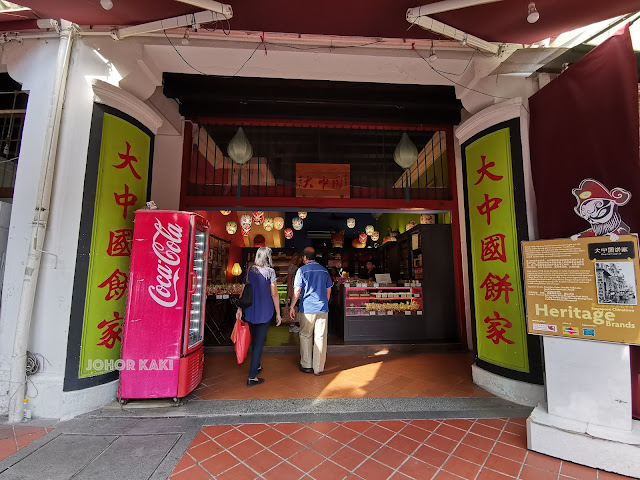
Founded by Tham Kai Chee in 1935 right here on this street, Tai Chong Kok 大中国 is famous for their traditional Cantonese style pastries, mooncakes and Chinese New Year nian gao (like Tai Thong on Mosque Street). Tai Chong Kok still make their own mooncake fillings like lotus seed paste from scratch, and never buy ready made from factories. They also use no preservatives in their cakes.
Trengganu Street 丁加奴街
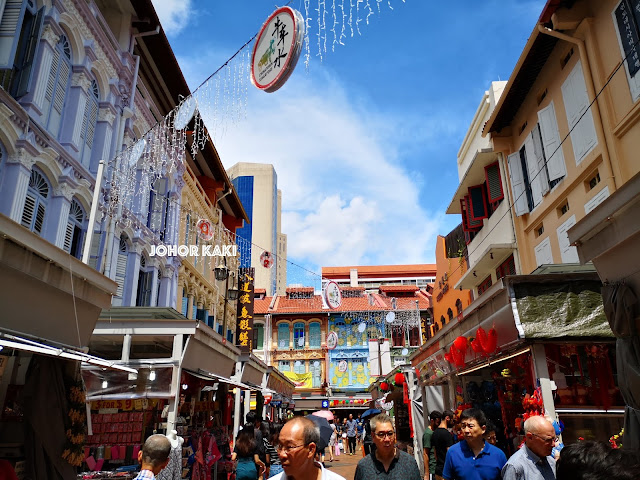
A side street that intersects Pagoda Street, Temple Street, Smith Street and Sago Street. Used to be called Hei Yun Wang Kai or Theatre Side Street, referencing the opera house which was the entertainment hub of old Chinatown. Traditionally, the street was abuzz with hawkers spilling over from Smith Street. Today, it is home to small food stalls and trinket shops.

At Trengganu Street food alley, we visit Old Amoy Chendol. One of the few authentic chendol stalls left in Singapore.
Read more about Old Amoy Chendol 👈 click
At Trengganu Street, we sample satay and rickshaw noodles (pop up stalls opened only for 5 Foot Way Festival 2019).

Satay is a dish enjoyed by all communities in Singapore. Satay originally from Indonesia is small pieces of spice marinated meat (usually chicken or lamb) skewered with a skinny wooden stick and grilled over charcoal fire. The grilled meat is eaten with a peanut sauce cooked with spices.

Rickshaw noodles was one of the staples that fuelled the human powered "taxis" of early Chinatown. Made simply of wheat flour, water and salt, the starchy noodles were eaten with vegetable soup.
Available at Trengganu Street only during the 5 Foot Way Festival. If you like to try it at other times, you can get it at China Street Rickshaw Noodles at Maxwell Food Centre and Tao Yuan at Beo Crescent Market & Food Centre.

Indonesian kueh stall serves various freshly hand made traditional street snacks including probably the best putu bambu (bamboo cake) in Singapore today.
Read more about Indo Sumatera stall 👈 click
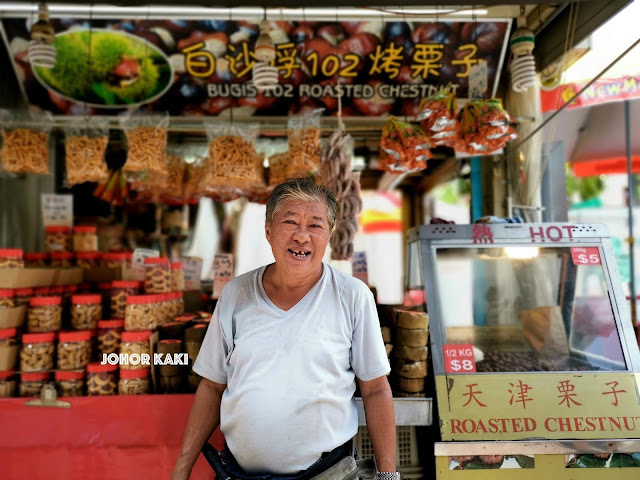
Roasted Chestnut stall - a handy snack Singaporeans grow up with. Once upon a time in Singapore, where there were wayang, there will be gao lak stalls. Today, Mr Black or Ah Orh is one of the last roasted chestnut men in Singapore. After him, there may be no more.
Read more about Ah Orh's roasted chestnut stall 👈 click

Fatty Weng 肥仔榮酒家 - modern Cantonese restaurant that still features old school signature dishes like deep fried soon hock fish and honey pork ribs from its street side 煮炒 zhi char roots dating back to 1967. This location was a partnership between Fatty Weng and Tai Thong Hoi Kee originally from Mosque Street. Tai Thong Hoi Kee was a Chinatown stalwart while Fatty Weng was founded on Albert Street.
Smith Street 史密斯街

Smith Street was named after Sir Cecil Clementi Smith who was Governor of the Straits Settlements from 1887 to 1893. The locals call it Hei Yun Kai or Theatre Street as there was a Cantonese opera house from the 1880s which was later converted to a cinema in the 1920s. The cinema closed after it was damaged by Japanese bombs during the Second World War.
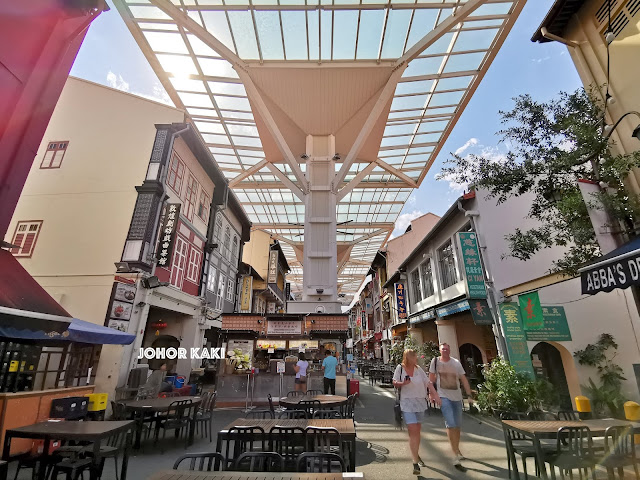
Smith Street was once the culinary core of Chinatown with the street teeming with the best street hawkers of Singapore. Most of these heritage hawkers were moved into Chinatown Complex Food Centre when it opened in the 1983. A handful still operate their stalls over there to this day.
Read about these heritage street hawkers 👈 click

Smith Street itself today is occupied by a food court operator and restaurants serving cuisine of post Millennium Chinese immigrants e.g. Sichuan, Beijing, Mongolian and Manchurian.
Still, there are traces of old Nanyang Singapore, though not much.

At 30 Smith Street, Chia Hou founded 泉昌 Chuen Cheong "Tiger Brand" soya sauce in 1930. (Today, the shop is occupied by a Sichuan restaurant.) It is the oldest surviving soya sauce maker in Singapore. Chuen Cheong is today a leading soya sauce and condiment manufacturer with its modern factory in Woodlands (Singapore's far north). Their soya sauce is my personal favourite for everyday use.
That side lane beside Chuen Cheong, linking Smith Street and Temple Street was a hotspot for gang clashes. It and the back lane behind Chuen Cheong were also the escape route for illegal opium den users.
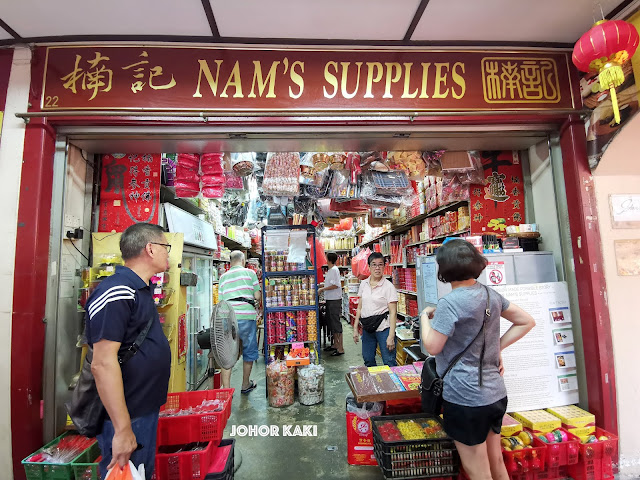
On Smith Street is one of the last remaining funerary supplies shops in Singapore. Nam's Supplies is also in its last legs as there is no one taking over from the elderly owners.

The legendary New Nam Thong Tea House is today an organic vegetarian restaurant/ cafe. New Nam Thong's owner's daughter Maria sold the restaurant's famed soya sauce chicken at her own hawker stall in Chinatown Complex. Hawker Chan of Liao Fan soya chicken Michelin One Star fame once worked at Maria's stall. We can say, Singapore's first hawker Michelin Star has a bit of DNA from this shophouse on Smith Street.
Please share your Chinatown stories in the comments. Thank you.
Dates: 23 & 24 Mar 2019
This trail was created for the Five Foot Way Festival (23 & 24 Mar 2019) organised by the Chinatown Business Association in conjunction with the Singapore Bicentennial.
Johor Kaki's food trail inside Chinatown Complex Food Centre 👈 click





Today's Chinatown is clean, well organized and spaced out but it is a shadow of its former self. It is artificial, without character and just another shopping mall with a food court albeit not air conditioned. Too well a job was done restoring it until it has lost its original flavour. Pity the tourists seeing something that is no longer authentic and full of character as before. Go to some surrounding countries and see their Chinatown. It is much more representative of history.
ReplyDelete